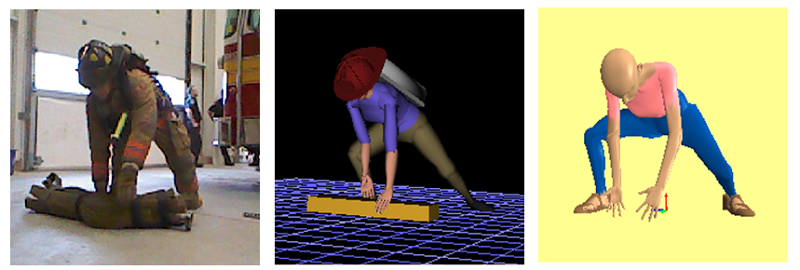
What is the problem?
Firefighters are injured at high rates during fire suppression tasks. A number of factors may contribute to this injury rate, including: 1) the loads being lifted, carried, or held, 2) the postures used by the firefighters, 3) the protective equipment worn by the firefighters, and 4) personal factors like age, sex, training, and experience. Conducting accurate ergonomic assessments of firefighting tasks to understand the injury risk is challenging because it is difficult to measure the impact of the heavy equipment worn by firefighters. We wanted to know if virtual reality, specifically digital human models, could help us understand the influence of firefighter postures and their equipment on injury risks by producing a computer model of the tasks using real firefighter data.
How did the team study the problem?
We collected data from 6 male and 6 female career firefighters in full bunker gear using a special camera (Microsoft KinectTM) as they lifted a high-rise hose pack (19.5 kg) from the ground. We then transferred the data into two virtual reality software programs (Jack (middle picture), and 3DSSPP (bottom picture)) to recreate the lift posture using digital human models. We also made a special biomechanical model so that we could better understand how much the weight of the self-contained breathing apparatus (SCBA) (17.5 kg) and other bunker gear (8.3 kg) influenced the injury risk to firefighters.
What did the team find?
Lifting a high-rise hose pack from the ground in full bunker gear can place firefighters at risk of injury due to the high loads experienced by the body. Some firefighters, including some females, used postures that were more protective than others.
How can this research be used?
Although the use of virtual reality for assessing firefighter injury risk is just beginning, this new method shows potential as a useful way of understanding how difficult-to-measure tasks, postures, and loads affect injury risks in firefighters.
Cautions
This study measured postures during a simulated high-rise hose pack lift and carry task in a firefighter training facility. Real fire situations are more complex and may cause firefighters to move in ways other than what was captured in this study. Furthermore, this study was limited to observations of 12 career firefighters from a single service in Ontario. Other firefighters may perform the task differently.
Funding Sources: Canadian Institutes for Health Research (FRN: 114112)
